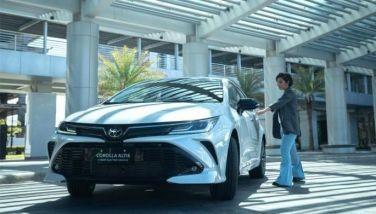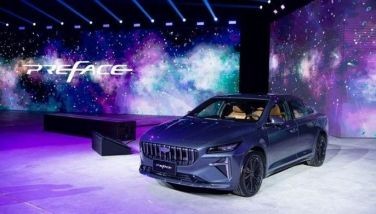A deflating drive of the BMW 320d
This is probably the first test drive story of a BMW wherein the car is upstaged by something as seemingly secondary as a tire.
But after three days of enjoying the 320d’s whopping reserves of torque (340Nm from its 2-liter common-rail turbodiesel engine), its superb handling (without compromising its supple ride quality one whit), its roomy and luxurious interior, and of course the cachet of driving the latest generation E90 3-series model, I had the misfortune of dropping my right wheels at about 40 kph into a nasty (read: really, really deep) pothole hidden by shadows from a large tree.
It was the sort of impact that would make you cringe. Thankfully, the BMW’s solid structure and robust suspension shrugged off the impact.
From experience, I knew it was always the alloy wheel or the tire that would take the brunt. In this case, it was the breathtakingly expensive 18-inch 40-series Bridgestone run-flat tire.
The car continued to run for a couple of minutes as if nothing happened – until I heard a soft chime from the instrument panel accompanied by a red exclamation-point-inside-a-triangle warning light which I instantly knew meant bad news.
The right front tire was slowly deflating and the ABS sensor detected a change in its rotational speed relative to the other three. Smart car.
I stopped and took a look at the tire. I didn’t even have to look long as I could hear the air hissing out of the pinhole-sized tear on the sidewall. Darn.
I called the ever-efficient Senior Corporate Communications Manager of BMW Philippines Leana Farrales (who turned out to be in London at that time) to explain the situation.
Her reply? “No problem! Are you okay? That tire can be driven for 80 kilometers at speeds up to 80 kph. Just don’t exceed that and you and the car will be fine.”
Is that cool or what?
Unnerved (and not wanting to damage the expensive alloy rims) I drove straight to my office where I left the car over the weekend (it was a Saturday) before its scheduled return to BMW Autohaus in Libis that Monday.
Monday morning came and the car – now tilting a bit because of the flat right front – started normally, backed out of our steep garage and proceeded to cruise merrily to its destination as if nothing happened.
There was a slight pull to the right due to the flat but other than that (and the constant warning light), there was no hint that anything was wrong. Passengers wouldn’t even notice. Heck I expected other motorists to point to my flat but the ultra-low profile tires made the flat look almost normal.
The car simply performed as flawlessly as any P2.99-million car can be expected.
On the way to the BMW dealership, I suddenly remembered all the run-flat tire driving exercises I have experienced here and abroad, the first of which was the very first world press drive of – appropriately enough – the BMW 5-series in exotic Sardinia in Italy back in 2003.
In that exercise, BMW technicians completely deflated one rear tire of a 530i and then let the assembled members of the press (one at a time, of course) drive the car through a slalom course as quickly as possible.
The driving exercise aimed to highlight two things. First, it showed how run-flat tires running on zero air pressure can retain the crucial contact patch between the car and the road without being literally peeled off the alloy rims – even at high cornering speeds.
Second, it demonstrated BMW’s famed Dynamic Stability Control (DSC), which electronically actuates individual brakes and even reduces the amount of throttle given to the engine (even if the driver insists on flooring the accelerator) to keep the car from spinning out, regardless of driving conditions – yes, even with four flat tires.
Which is why I felt that DSC is perfectly suited to the 320d. The car’s 4-cylinder turbocharged common-rail motor 320d develops a seemingly low 163 bhp but marries this with a whopping 340 Nm of torque available at an incredibly low 2000rpm.
In contrast, the bigger-engined gasoline-fed BMW 325i develops a stronger 218 bhp but can only muster 250 Nm of torque.
Those numbers are enough to give the 320d a top speed of 225 kph and a 0 to 100-kph acceleration time of a brisk 8.3 seconds – all the while delivering an observed fuel economy of 12 kilometers per liter in mostly gridlocked traffic. (Expect as high as 17 kpl when cruising.)
Two other features I like with the latest 3-series is the push-button engine start and the 6-speed automatic Steptronic manumatic gearbox (having six speeds allows BMW to fit the car with a shorter 1st gear for stronger acceleration, a longer top gear for relaxed and fuel-efficient cruising, and better spaced gearing in between).
Of course, there is also the trademark BMW driving dynamics that come standard with any car wearing the famed spinning-propeller logo.
Now if all these aren’t enough to convince me (not that I need convincing) or any BMW naysayer what a terrific overall package the 320d represents, I don’t know what will.
The Good
• Immense levels of torque for astounding and effortless acceleration
• Legendary BMW ride and handling
• Athletic stopping power
• Cool 6-speed automatic Steptronic gearbox
• Luxurious and well-equipped cabin
• Lots of comfort, convenience and safety features
• Life- and time-saving run-flat tires
The Bad
• I can’t afford one
The Verdict
• A sport sedan that gives you the best of all worlds: prestige, comfort, safety, performance and yes, even fuel economy.
- Latest




























